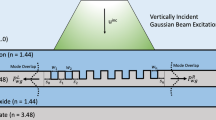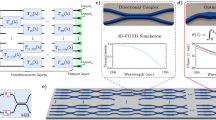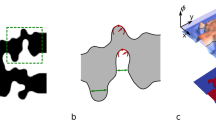Abstract
Integrated photonic devices are poised to play a key role in a wide variety of applications, ranging from optical interconnects1 and sensors2 to quantum computing3. However, only a small library of semi-analytically designed devices is currently known4. Here, we demonstrate the use of an inverse design method that explores the full design space of fabricable devices and allows us to design devices with previously unattainable functionality, higher performance and robustness, and smaller footprints than conventional devices5. We have designed a silicon wavelength demultiplexer that splits 1,300 nm and 1,550 nm light from an input waveguide into two output waveguides, and fabricated and characterized several devices. The devices display low insertion loss (∼2 dB), low crosstalk (<−11 dB) and wide bandwidths (>100 nm). The device footprint is 2.8 × 2.8 μm2, making this the smallest dielectric wavelength splitter.
This is a preview of subscription content, access via your institution
Access options
Subscribe to this journal
Receive 12 print issues and online access
$209.00 per year
only $17.42 per issue
Buy this article
- Purchase on Springer Link
- Instant access to full article PDF
Prices may be subject to local taxes which are calculated during checkout




Similar content being viewed by others
References
Miller, D. A. B. Optical interconnects to electronic chips. Appl. Opt. 49, F59–F70 (2010).
Lin, V. S. Y., Motesharei, K., Dancil, K.-P. S., Sailor, M. J. & Ghadiri, M. R. A porous silicon-based optical interferometric biosensor. Science 278, 840–843 (1997).
Kok, P. et al. Linear optical quantum computing with photonic qubits. Rev. Mod. Phys. 79, 135–174 (2007).
Reed, G. T. Silicon Photonics: The State of the Art (Wiley, 2008).
Lu, J. & Vučković, J. Nanophotonic computational design. Opt. Express 21, 13351–13367 (2013).
Ashenden, P. J. The Designer’s Guide to VHDL 3rd edn (Morgan Kaufmann, 2008).
IEEE Standard for Verilog Hardware Description Language, IEEE Std. 1364–2001 (IEEE, 2001).
Jensen, J. S. & Sigmund, O. Systematic design of photonic crystal structures using topology optimization: low-loss waveguide bends. Appl. Phys. Lett. 84, 2022 (2004).
Borel, P. I. et al. Topology optimization and fabrication of photonic crystal structures. Opt. Express 12, 1996–2001 (2004).
Mutapcica, A., Boyd, S., Farjadpour, A., Johnson, S. G. & Avnielb, Y. Robust design of slow-light tapers in periodic waveguides. Eng. Optimiz. 41, 365–384 (2009).
Jensen, J. S. & Sigmund, O. Topology optimization for nano-photonics. Laser Photon. Rev. 5, 308–321 (2011).
Lalau-Keraly, C. M., Bhargava, S., Miller, O. D. & Yablonovitch, E. Adjoint shape optimization applied to electromagnetic design. Opt. Express 21, 21693–21701 (2013).
Niederberger, A. C. R., Fattal, D. A., Gauger, N. R., Fan, S. & Beausoleil, R. G. Sensitivity analysis and optimization of sub-wavelength optical gratings using adjoints. Opt. Express 22, 12971–12981 (2014).
Piggott, A. Y. et al. Inverse design and implementation of a wavelength demultiplexing grating coupler. Sci. Rep. 4, 7210 (2014).
Boyd, S. & Vandenberghe, L. Convex Optimization (Cambridge Univ. Press, 2004).
Xia, F., Rooks, M., Sekaric, L. & Vlasov, Y. Ultra-compact high order ring resonator filters using submicron silicon photonic wires for on-chip optical interconnects. Opt. Express 15, 11934–11941 (2007).
Fang, Q. et al. WDM multi-channel silicon photonic receiver with 320 Gbps data transmission capability. Opt. Express 18, 5106–5113 (2010).
Alduino, A. et al. in Integrated Photonics Research, Silicon and Nanophotonics and Photonics in Switching, OSA Technical Digest PDIWI5 (Optical Society of America, 2010); http://go.nature.com/pG2HNU
Sasaki, K., Ohno, F., Motegi, A. & Baba, T. Arrayed waveguide grating of 70×60 μm size based on Si photonic wire waveguides. Electron. Lett. 41, 801–802 (2005).
Horst, F., Green, W. M. J., Offrein, B. J. & Vlasov, Y. A. Silicon-on-insulator echelle grating WDM demultiplexers with two stigmatic points. IEEE Photon. Technol. Lett. 21, 1743–1745 (2009).
Dahlem, M. S. et al. Reconfigurable multi-channel second-order silicon microring-resonator filterbanks for on-chip WDM systems. Opt. Express 19, 306–316 (2011).
Bogaerts, W. et al. Silicon-on-insulator spectral filters fabricated with CMOS technology. IEEE J. Quantum Electron. 16, 33–44 (2010).
Frandsen, L. H., Elesin, Y., Sigmund, O., Jensen, J. S. & Yvind, K. in CLEO: 2013, OSA Technical Digest CTh4 L.6 (Optical Society of America, 2013); http://go.nature.com/atKRes
Miller, D. A. B. All linear optical devices are mode converters. Opt. Express 20, 23985–23993 (2012).
Osher, S. & Fedkiw, R. Level Set Methods and Dynamic Implicit Surfaces (Springer, 2003).
Lu, J. Nanophotonic Computational Design PhD thesis, Stanford Univ. (2013), available at http://web.stanford.edu/group/nqp/jv_files/thesis/Jesse-thesis.pdf.
Shin, W. & Fan, S. Choice of the perfectly matched layer boundary condition for frequency-domain Maxwell's equations solvers. J. Comput. Phys. 231, 3406–3431 (2012).
Shin, W. MaxwellFDFD webpage (2014), available at http://web.stanford.edu/~wsshin/maxwellfdfd.html.
Acknowledgements
This work was supported by the Air Force Office of Scientific Research Multi-University Research Initiative (programme director G. Pomrenke; grant no. FA9550-09-1-0704). A.Y.P. acknowledges support from the Stanford Graduate Fellowship. K.G.L. acknowledges support from the Swiss National Science Foundation. J.P. was supported in part by the National Physical Science Consortium Fellowship and by stipend support from the National Security Agency. The authors thank S. Boyd for his theoretical guidance and discussions regarding the optimization algorithm. In addition, the authors thank J. Poon for the donation of the SOI wafer used to fabricate the devices.
Author information
Authors and Affiliations
Contributions
A.Y.P. designed, simulated, fabricated and measured the devices. J.L. developed the inverse design algorithm and software. K.G.L. assisted in building the measurement set-up. J.P. contributed to the simulation software. T.B. provided theoretical and experimental guidance. J.V. supervised the project. All members contributed to the discussion and analysis of the results.
Corresponding author
Ethics declarations
Competing interests
The authors declare no competing financial interests.
Supplementary information
Supplementary information
Supplementary information (PDF 332 kb)
Supplementary information
Supplementary movie 1 (MOV 147 kb)
Rights and permissions
About this article
Cite this article
Piggott, A., Lu, J., Lagoudakis, K. et al. Inverse design and demonstration of a compact and broadband on-chip wavelength demultiplexer. Nature Photon 9, 374–377 (2015). https://doi.org/10.1038/nphoton.2015.69
Received:
Accepted:
Published:
Issue Date:
DOI: https://doi.org/10.1038/nphoton.2015.69
This article is cited by
-
Deep photonic network platform enabling arbitrary and broadband optical functionality
Nature Communications (2024)
-
Lithography-free reconfigurable integrated photonic processor
Nature Photonics (2023)
-
A comprehensive deep learning method for empirical spectral prediction and its quantitative validation of nano-structured dimers
Scientific Reports (2023)
-
Large area optimization of meta-lens via data-free machine learning
Communications Engineering (2023)
-
Inverse-designed silicon carbide quantum and nonlinear photonics
Light: Science & Applications (2023)



